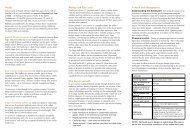Bushland Weeds Manual - Environmental Weeds Action Network
Bushland Weeds Manual - Environmental Weeds Action Network
Bushland Weeds Manual - Environmental Weeds Action Network
You also want an ePaper? Increase the reach of your titles
YUMPU automatically turns print PDFs into web optimized ePapers that Google loves.
62<br />
Chapter 5 Broadleaf Herbs, Sedges and Succulents<br />
Case Studies<br />
Case study 5.2 Preventing further spread of a recent invader – Holly-leafed Senecio<br />
(Senecio glastifolius)<br />
Holly-leafed Senecio, a tall perennial<br />
herb from the daisy family, occurs<br />
naturally in the Cape Region of<br />
South Africa. It was first recorded<br />
as naturalised in Western Australia<br />
in 1986 (Western Australian<br />
Herbarium 1998). Collected from<br />
the Mt Adelaide and Mt Clarence<br />
Nature Reserves in the south west<br />
town of Albany, Holly-leafed Senecio<br />
was apparently an escapee from a<br />
garden adjoining the reserve. A<br />
series of fires facilitated rapid<br />
expansion of the original infestation<br />
and slashing of fire breaks<br />
contributed to further spread of<br />
seed. Holly-leafed Senecio now<br />
occurs throughout much of the 260<br />
hectares of Jarrah (Eucalyptus<br />
marginata), Albany Blackbutt<br />
(Eucalyptus staeri), and Marri<br />
(Eucalyptus calophylla) woodlands,<br />
as well as Allocasuarina open<br />
woodland, in the reserves. In recent<br />
years infestations have also been<br />
found growing on coastal sands and<br />
loams up to 20 kilometres from the<br />
original infestation (Western<br />
Australian Herbarium 1998). Hollyleafed<br />
Senecio has the potential to<br />
become a major weed of natural<br />
areas around much of the south<br />
coast of Western Australia<br />
(Keighery 1999c).<br />
Senecio glastifolius (photograph Greg Keighery)<br />
Why is it such a successful<br />
weed?<br />
• Produces prolific amounts of<br />
viable, wind dispersed seed.<br />
• Some evidence of persistent<br />
soil seedbank.<br />
• Fire is a major mechanism for<br />
establishment and facilitates<br />
spread.<br />
• Soil disturbance also facilitates<br />
spread and establishment.<br />
(from Williams et al. 1999)<br />
Management<br />
The Mt Adelaide and Mt Clarence<br />
Nature Reserves are vested in the<br />
City of Albany. Until very recently<br />
few resources have been available<br />
for weed management in the<br />
Reserves. Although the original<br />
infestation of Holly-leafed Senecio<br />
threatened natural areas from<br />
Augusta to Albany and possibly<br />
beyond, it was never clear who was<br />
responsible for its eradication.<br />
Community volunteers initiated the<br />
first control programs.<br />
The following report comes<br />
from Karin Baker, Friends of<br />
Mt Adelaide and Mt Clarence<br />
Nature Reserves<br />
• 1998: Fire followed by good<br />
rains led to prolific germination<br />
of Holly-leafed Senecio on the<br />
north face of the saddle<br />
between Mt Adelaide and Mt<br />
Clarence. Many people who<br />
used the reserves for their<br />
daily walks started hand-pulling<br />
the plants and leaving them in<br />
the Reserves. (It was not known<br />
at this stage that they could<br />
form seeds after being pulled).<br />
Three community volunteers<br />
started a hand-removal<br />
program in a Casuarina open<br />
woodland area, where the<br />
thickest infestations occurred.<br />
• 1999: Holly-leafed Senecio was<br />
hand-removed from dense<br />
thickets of Acacia pulchella up<br />
to 700 mm high. Hand-pulling in<br />
this area required thick gloves<br />
and trousers. Some of the Hollyleafed<br />
Senecio removed was<br />
two and a half metres tall. This<br />
time the plants were removed<br />
from the site. We were learning!<br />
• John Moore and Dale Baker, a<br />
board member of the first CRC<br />
(Cooperative Research Centre)<br />
for Weed Management Systems<br />
ran a series of herbicide trials.<br />
Lontrel at 500 mL/ha applied<br />
from a backpack mister in<br />
spring was found to be effective<br />
on the Holly-leafed Senecio and<br />
caused little damage to the<br />
native species in the area.<br />
• The CRC for <strong>Weeds</strong> and the<br />
Department of Agriculture,<br />
Western Australia held the<br />
state launch of ‘Weedbuster<br />
Week’ at the Mt Adelaide and<br />
Mt Clarence Reserves in<br />
October. Over 100 people<br />
turned up to hand-pull Hollyleafed<br />
Senecio and the ‘Friends<br />
of Mt Adelaide & Mt Clarence<br />
Reserves’ was formed. The<br />
following year the Bushcarers<br />
Group, an umbrella group for<br />
all the Friends groups that were<br />
starting up around the city was<br />
formed.<br />
• Following on from the work<br />
day, populations were sprayed<br />
with Lontrel (500 mL/ha).



